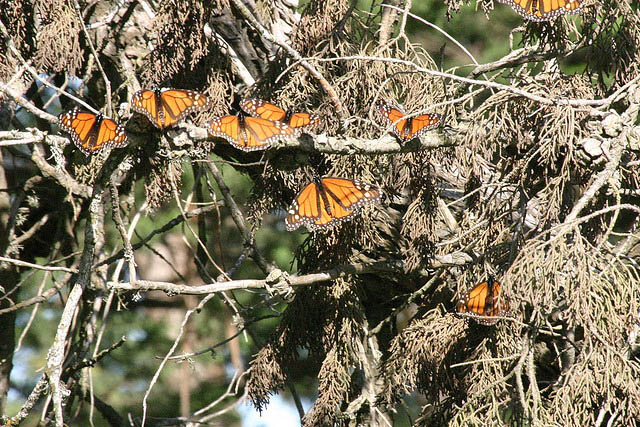The 56,259 ha biosphere lies within rugged forested mountains about 100 km northwest of Mexico City. Every autumn, millions, perhaps a billion, butterflies from wide areas of North America return to the site and cluster on small areas of the forest reserve, colouring its trees orange and literally bending their branches under their collective weight. In the spring, these butterflies begin an 8 month migration that takes them all the way to Eastern Canada and back, during which time four successive generations are born and die. How they find their way back to their overwintering site remains a mystery.
 |
| Monarch Butterfly |
The Monarch Butterfly Biosphere Reserve World Heritage property protects key overwintering sites for the monarch butterfly. The overwintering concentration of butterflies in the property is a superlative natural phenomenon. The millions of monarch butterflies that return to the property every year bend tree branches by their weight, fill the sky when they take flight, and make a sound like light rain with the beating of their wings. Witnessing this unique phenomenon is an exceptional experience of nature.
The overwintering concentration of the monarch butterfly in the property is the most dramatic manifestation of the phenomenon of insect migration. Up to a billion monarch butterflies return annually, from breeding areas as far away as Canada, to land in close-packed clusters within 14 overwintering colonies in the oyamel fir forests of central Mexico. The property protects 8 of these colonies and an estimated 70% of the total overwintering population of the monarch butterfly’s eastern population.
The property includes more than half of the overwintering colonies of the monarch butterfly’s eastern population. They provide a good sample of the areas that are essential for maintaining this superlative natural phenomenon. The maintenance of the standing forest and the microclimates that they create is the key management requirement, thus any threat to the forests is of utmost concern. Illegal logging is a known threat to the property with potential direct impacts on its Outstanding Universal Value. Public use has been increasing and the levels of visitation and infrastructure provided require careful control both in relation to impacts on the ecosystem and the quality of experience provided by the property to visitors. Due to its migratory nature, the maintenance of the overwintering phenomenon also requires attention to the conservation of the monarch butterfly by those countries through which it travels during its life cycle.
The principal focus of protection and management should be to prevent illegal logging in the property. Priorities to achieve this include concerted planning and action between all relevant federal, state and local agencies, and work with local communities on environmental protection and the provision of alternative livelihoods to logging. As the overwintering phenomenon is a significant attractor to visitors, management also needs to be directed to achieving sustainable public use of the property. This should respect the quality of the visitor experience and promote benefit-sharing mechanisms for local communities as an incentive to enhance their support to the conservation of the property. Continued investment in coordinated continent-wide management of the migratory phenomenon is a further important dimension of site management. Achieving all of these priorities requires the provision of adequate and sustained institutional and financial support.
 |
| Monarch Butterfly Biosphere Reserve |
Text source:- Wikipedia. Images are copyrighted by their owners. Found any copyright issue, contact the administrator immediately. Report it now!
You have read this article Heritage /
Heritage Cultural /
Mexico /
North America /
North America Heritage
with the title Monarch Butterfly Biosphere Reserve. You can bookmark this page URL http://tiffanyeatworld.blogspot.com/2011/12/monarch-butterfly-biosphere-reserve.html. Thanks!


















